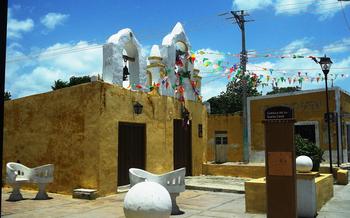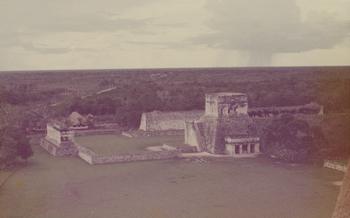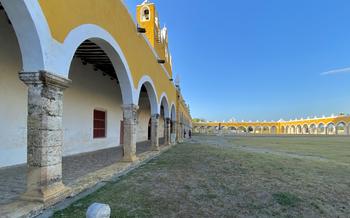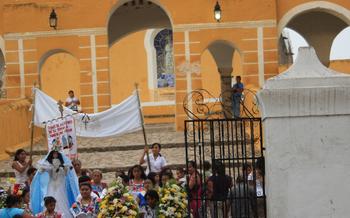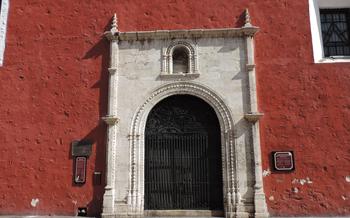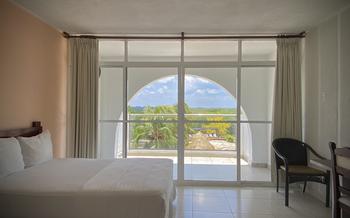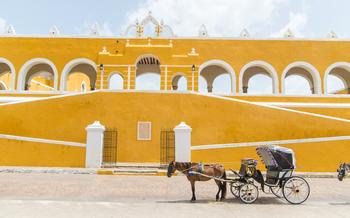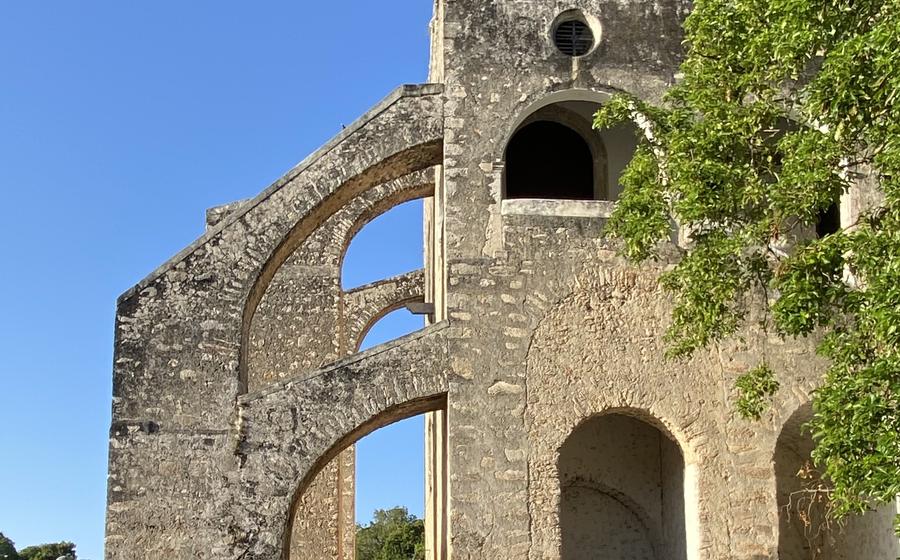
Convento de San Antonio de Padua
- Convento de San Antonio de Padua: A Majestic Icon
- Exploring the Convent's Exterior
- Stepping Inside the Convent
- The Atrium: A Place of Tranquility
- The Cenote: A Natural Wonder
- Izamal's Magical Landscapes
- Exploring Beyond the Convent
- Shopping for Local Handicrafts
- Accommodations for Every Traveler
- Festivals and Celebrations in Izamal
- Insider Tip: Hidden Gems of Izamal
Convento de San Antonio de Padua: A Majestic Icon
The Convento that shaped Izamal's history. Its construction, spanning from 1561 to 1618, showcased the blending of Spanish and Mayan architectural styles, resulting in a unique masterpiece that has earned its place among the most impressive religious landmarks in Mexico. The convent's design reflects the transition from Gothic to Renaissance styles, incorporating elements such as ribbed vaults, intricate stone carvings, and ornate facades.
Beyond its architectural significance, the Convento de San Antonio de Padua holds immense historical relevance. It served as a pivotal center for the Franciscan missionaries who played a crucial role in spreading Christianity throughout the Yucatán Peninsula. Within its walls, countless indigenous Maya were baptized and introduced to the Catholic faith. The convent also functioned as a school, where both Maya and Spanish children received education and religious instruction.
Exploring the Convent's Exterior
As you stand before the Convento de San Antonio de Padua, its imposing façade commands your attention. The intricate carvings and sculptures that adorn the walls narrate stories from the Bible, while the grand atrium invites you to step inside and explore this architectural masterpiece.
The convent's façade is a testament to the skill and artistry of the Franciscan friars who built it. The central doorway is flanked by two bell towers, each topped with a cross. The towers are adorned with intricate carvings, including representations of the four evangelists and the twelve apostles.
The atrium is a large, open space that serves as a gathering place for the community. It is surrounded by a series of arches, which support the convent's second story. The arches are decorated with colorful tiles, which create a vibrant and inviting atmosphere.
Notable sculptures and statues can be found throughout the atrium. One of the most striking is a statue of St. Anthony of Padua, the patron saint of the convent. The statue depicts the saint holding a lily and a book, symbols of his purity and his dedication to learning.
Archaeological discoveries have been made on the grounds of the convent, including the remains of a pre-Columbian pyramid. These discoveries suggest that the site was once home to a Maya settlement, which was later abandoned and taken over by the Franciscans.
Stepping Inside the Convent
Venturing into the heart of Convento de San Antonio de Padua, visitors are greeted by the awe-inspiring main church, a testament to the grandeur of colonial architecture. Its intricate altarpieces, adorned with gold leaf and vibrant colors, depict scenes from the life of Christ and the saints. The intricate murals and paintings that grace the walls and ceilings narrate biblical stories and showcase the artistic prowess of the region's master painters.
Notable chapels and side altars, each dedicated to a specific saint or religious figure, line the sides of the church. These chapels, with their unique architectural styles and decorative elements, offer a glimpse into the diverse religious traditions and beliefs of the community. Historic artifacts and relics, carefully preserved and displayed, provide tangible links to the rich history of the convent and the region.
The Atrium: A Place of Tranquility
The atrium of the Convento de San Antonio de Padua is a serene and inviting space that offers a respite from the bustling city streets. The central fountain, with its cascading waters and intricate carvings, serves as a focal point, creating a sense of tranquility and harmony. The surrounding gardens, filled with lush vegetation and colorful flowers, add to the peaceful ambiance, inviting visitors to sit, relax, and soak in the beauty of their surroundings.
The atrium is not just a physical space but also a place of spiritual significance. It is here that the community gathers for religious ceremonies and processions, seeking solace and guidance within the sacred walls of the convent. The peaceful atmosphere of the atrium fosters a sense of contemplation and reflection, allowing visitors to connect with their inner selves and find moments of serenity amidst the vibrant energy of Izamal.
The Cenote: A Natural Wonder
Within the sacred grounds of the Convento de San Antonio de Padua lies a hidden gem that transports visitors to a realm of natural wonder and ancient mystique. The cenote, a natural sinkhole filled with crystal-clear water, is a testament to the region's rich geological history and cultural significance.
Descended from the Mayan word "ts'onot," meaning "sacred well," cenotes were revered by the ancient Maya as gateways to the underworld and sources of life-giving water. The cenote at the Convento de San Antonio de Padua holds a special place in the hearts of both locals and visitors, offering a unique opportunity to immerse oneself in the beauty and mystery of this natural wonder.
With its cool, refreshing waters and otherworldly ambiance, the cenote beckons visitors to take a dip and experience its rejuvenating powers. The water's crystal-clear clarity allows for breathtaking views of the underwater world, revealing intricate rock formations and a diverse array of aquatic life.
For those seeking a more adventurous experience, the cenote offers opportunities for swimming, snorkeling, and even diving. Explore the hidden depths of this natural wonder, marveling at the stunning underwater landscapes and the vibrant marine life that calls the cenote home.
Whether you choose to simply relax and soak in the tranquil ambiance or embark on an underwater adventure, the cenote at the Convento de San Antonio de Padua promises an unforgettable experience that blends history, nature, and spirituality in a truly magical way.
Izamal's Magical Landscapes
Izamal exudes a unique charm with its vibrant colonial architecture, painted in a kaleidoscope of colors that dance harmoniously under the warm Mexican sun. Strolling along the cobblestone streets, you'll be captivated by the pastel-hued facades of traditional houses, each adorned with intricate details and decorative flourishes.
Horse-drawn carriages, known as calesas, add to the city's charm, providing a delightful and nostalgic mode of transportation. Take a leisurely ride through the narrow streets, letting the gentle clopping of hooves and the rhythmic sound of wheels transport you back in time.
Don't miss the opportunity to explore Izamal's vibrant markets, where you can immerse yourself in the local culture and find unique handmade crafts, textiles, and souvenirs. Indulge in the region's culinary delights, savoring the flavors of traditional Yucatecan cuisine at local restaurants or trying some of the delectable street food offerings.
Izamal's vibrant energy and rich cultural heritage create a magical tapestry that weaves together history, tradition, and modern-day charm. As you wander through this captivating city, you'll discover countless hidden gems that will leave you enchanted and forever captivated by the magic of Izamal.
Exploring Beyond the Convent
Venturing beyond the walls of Convento de San Antonio de Padua, immerse yourself in the captivating tapestry of Izamal. A short stroll leads you to the Centro Histórico, where vibrant colonial architecture lines the enchanting streets, each painted in a kaleidoscope of colors. Wander through the vibrant plazas, where horse-drawn carriages await, ready to transport you back in time.
Discover the ancient pyramids of Kinich Kakmó and Kabul, remnants of a rich Mayan past, nestled just outside the city. Explore the exquisite Museo de los Santos Reyes, showcasing an impressive collection of religious art and artifacts, providing a glimpse into the town's spiritual heritage.
Venture to the nearby town of Tunkás, renowned for its traditional Mayan handicrafts. Browse the vibrant markets, where skilled artisans display their intricate textiles, colorful pottery, and hand-woven hammocks, perpetuating centuries-old craft traditions.
Immerse yourself in the local culture by joining cooking classes, learning to prepare mouthwatering Yucatecan dishes using fresh ingredients and traditional recipes. Discover the secrets of making handmade tortillas, flavorful salsas, and the iconic Cochinita Pibil, a slow-roasted pork dish wrapped in banana leaves.
Whether seeking adventure or relaxation, Izamal and its surroundings offer a myriad of experiences. Embrace the warmth of the local people, delve into the vibrant traditions, and savor the rich flavors that make this region a true gem of the Yucatán Peninsula.
Shopping for Local Handicrafts
Izamal is a treasure trove for those seeking authentic Mexican handicrafts and souvenirs. The city's vibrant markets and artisan workshops display a dazzling array of traditional textiles, intricate embroidery, colorful pottery, and unique handcrafted goods. Visitors can immerse themselves in the local culture by bargaining for unique pieces that reflect the history and artistry of the region. Bargaining is not only acceptable but expected in the markets, so don't be afraid to engage with the friendly vendors and strike a deal. Remember to be respectful and mindful of local customs and traditions while shopping.
Accommodations for Every Traveler
Izamal offers a diverse range of accommodation options to suit every traveler's needs and budget. From cozy guesthouses to luxurious haciendas, there's something for everyone in this charming city.
For budget-conscious travelers, there are several hostels and guesthouses that offer basic but comfortable accommodations at affordable rates. These establishments often have a friendly and social atmosphere, making them ideal for solo travelers or groups of friends.
If you're looking for a more upscale experience, there are a number of boutique hotels and haciendas that offer a range of amenities and services. These properties typically feature beautifully appointed rooms, private pools, and fine dining restaurants.
No matter what your budget or preferences, you're sure to find the perfect place to stay in Izamal. Here are a few tips for finding the best accommodations:
- Book your accommodation in advance, especially if you're traveling during peak season.
- Consider your budget and what type of experience you're looking for.
- Read reviews of different properties before making a decision.
- Ask for recommendations from locals or other travelers.
With its variety of accommodation options, Izamal is the perfect place to relax and unwind after a day of exploring this beautiful city.
Festivals and Celebrations in Izamal
Izamal is a city that comes alive during festivities, showcasing its rich cultural heritage and religious traditions. One of the most significant events is the annual carnival, held before Lent. The streets burst with color and music as locals and visitors alike don elaborate costumes and dance to the rhythm of traditional music. Floats parade through the city, creating a vibrant and lively atmosphere.
Religious festivals are also integral to Izamal's cultural fabric. The Feast of San Antonio de Padua, the city's patron saint, is celebrated in June with processions, traditional dances, and special masses. The Feast of the Immaculate Conception in December is another major event, featuring processions, fireworks, and special decorations that illuminate the city's streets.
Throughout the year, Izamal hosts various cultural events, including music concerts, art exhibitions, and traditional dance performances. These events provide an opportunity to immerse oneself in the local culture and traditions. Visitors can also witness the traditional Mayan ceremony known as "Hanal Pixan," where families gather to honor their deceased loved ones during the Day of the Dead celebrations.
Attending festivals and celebrations in Izamal is an enriching experience that allows visitors to connect with the city's vibrant culture and traditions. By participating in these events, travelers can gain a deeper understanding of the local way of life and create lasting memories of their time in this enchanting city.
Insider Tip: Hidden Gems of Izamal
Beyond the popular tourist spots, Izamal offers a wealth of hidden gems waiting to be discovered by curious travelers. One such treasure is the ancient Cenote Zací, located just a short walk from the city center. This natural wonder features crystal-clear waters and a stunning cave system, perfect for swimming, diving, and exploring.
For those seeking a unique cultural experience, the Museo de la Medicina Maya (Maya Medicine Museum) is a must-visit. This fascinating museum showcases traditional Mayan healing practices and herbal remedies, offering a glimpse into the rich cultural heritage of the region.
Art enthusiasts will delight in the Galería de Arte Izamal, which exhibits a diverse collection of contemporary and traditional artwork by local artists. From paintings and sculptures to ceramics and textiles, the gallery offers a vibrant showcase of Izamal's creative spirit.
To discover the city's hidden culinary gems, venture off the main streets and explore the local markets and street food stalls. Sample regional delicacies such as cochinita pibil (slow-roasted pork), panuchos (fried tortillas filled with beans and meat), and salbutes (thick tortillas topped with turkey or chicken). These local flavors will tantalize your taste buds and provide an authentic culinary experience.
Whether you're seeking ancient wonders, cultural immersion, or culinary delights, Izamal's hidden gems offer a unique and unforgettable adventure for those willing to explore beyond the beaten path. Embrace the city's charm, uncover its secrets, and create memories that will last a lifetime.
